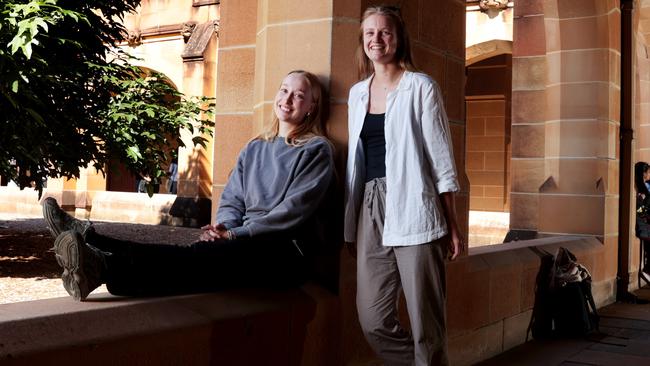International student visa numbers cut amid migration squeeze
The number of international student visa holders approved to come to Australia is on track to plummet, amid a push to curb the rate of net migration.

The number of international student visa holders approved to come to Australia is on track to plummet by more than 90,000 this financial year, as the federal government rejects an increasing number of applicants to curb the high levels of temporary migration.
The number of visas granted to offshore students dropped to 139,132 in the first half of the financial year, figures from the Department of Home Affairs reveal, with nearly 20 per cent of all applicants rejected. If the approval rate continues 91,715 fewer overseas students will arrive in 2023-24 compared with the past year.
International Education Association of Australia CEO Phil Honeywood said the figures were part of the government crackdown on giving visas to applicants who were more interested in work rights than study, which the government refers to as “non-genuine students”.
“The focus has been on winding back a large number of diploma-level vocational students doing courses such as diploma of leadership, and instead the primary focus is on students who can add skills to the Australian economy,” he said.
The total number of student visas approved – including for non-residents already in Australia – was 195,934, which is also on track to fall below the record 577,295 visas granted in 2022-23.
The change in the numbers is being driven by the number of rejected applicants, with 81 per cent of student visa requests being granted in the past six months.
This is down from 86 per cent of applicants being approved in 2022-23, 91.5 per cent in 2021-22 and 89.9 per cent in the pre-Covid year of 2018-19.
A Department of Home Affairs spokeswoman said visa approvals needed to be “balanced against upholding the integrity of the student visa program”.
“The department has seen increasing levels of integrity concerns across the student visa program,” she said.
“The department received higher levels of fraudulent documents, fraud related to English language testing, non-genuine claims and non-genuine subsequent marriages being presented in student visa applications.
“The department will refuse a visa application to non-genuine applicants who do not meet regulatory requirements and where fraud is present.”
Education Minister Jason Clare said Labor was committed to improving the standing of the nation’s higher education sector and combating exploitation.
“The Albanese government’s migration strategy and the other integrity measures we’ve put in place send a clear message that we will act to prevent the exploitation of students and protect Australia’s reputation as a high-quality international education provider,” he said.
A global push is under way to limit student migration, with Canada seeking to curb its numbers by announcing a two-year cap on foreign students that will cut numbers by 35 per cent, and Britain barring foreign students from bringing dependants.

Migration expert and former immigration department official Abul Rizvi said the decline in student visa approvals reflected a bid from the government to lower net migration and ease the pressure on infrastructure and the housing market.
“The reason I think the government is targeting students right now is to get net migration down to a more sustainable level,” he said. “And in our history, whenever net migration has hit or approached around 300,000, problems have occurred in terms of congestion, inadequate infrastructure and housing, but also many government services start to strain at that level of net migration.
“And of course last year, we hit over 500,000, which is the highest in our history and not surprisingly, all of those things are under strain as a result.”
Mr Rizvi said the Australian, Canadian and British governments’ different approaches to bringing down student numbers were all poorly designed, arguing that the Albanese government’s strategy of upping refusals wasted resources. “Australia’s approach has been to crank refusal rates,” he said. “I personally think all three countries have got it wrong; they’re just doing it badly.
“Not letting dependants come is poor practice, student visa capping in an arbitrary way and it’s also chaotic … and Australia’s approach is subjective refusal rates.
“That’s not very good either, it’s just a waste of resources.”
Opposition immigration spokesman Dan Tehan has accused Labor of pursuing a “Big Australia policy” and allowing a record intake of international students to help “drive overseas migration to a record 518,000 people as Australians endured housing shortages, rent hikes, and a cost-of-living crisis exacerbated by population growth”.
“Labor says they’re not running a Big Australia policy but they also said they would deliver the stage 3 tax cuts,” he said.
The rate of visas being granted to international students in the university education sector alone dropped to 82.5 per cent since July, from 87.5 per cent in 2022-23 and 96 per cent in 2021-22.
In the past six months 98,198 student visas have been granted for study in the higher education sector showing a trend downwards from 2022-23 when 261,317 visas were granted through the course of the year, the highest in more than a decade.
While the rate of overseas Chinese university students being granted visas offshore remained steady at about 97 per cent, grant rates for offshore higher education students from India, Australia’s second-biggest market, dropped from 74.2 per cent in 2022-23 to 60.8 per cent this financial year. Grant rates for the third-biggest market, Nepal, went from 65.2 per cent to 48.8 per cent in the same period.







To join the conversation, please log in. Don't have an account? Register
Join the conversation, you are commenting as Logout